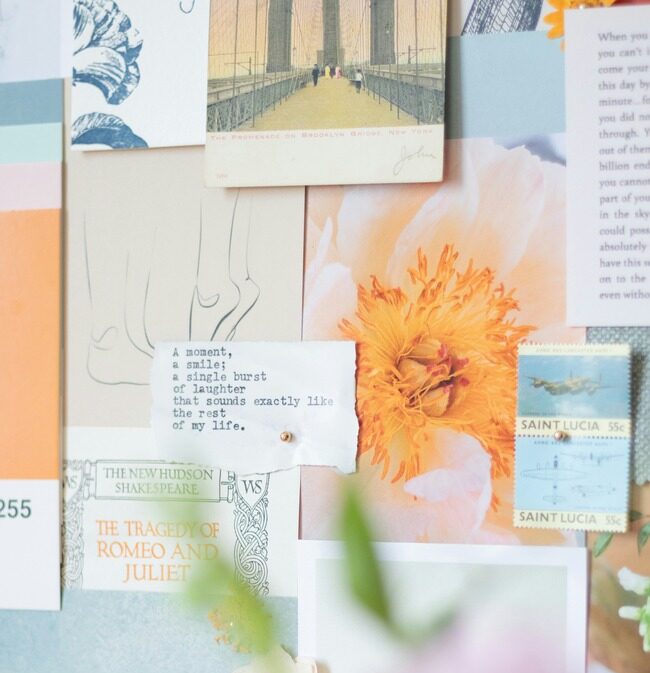
The Power of Moodboarding in Brand Marketing: A Complete Guide
Whether you’re launching a new business, rebranding, or planning a marketing campaign, aligning your visual identity with your brand’s message is essential—and one of the most powerful tools to achieve that is moodboarding.
Moodboarding may seem like a creative exercise reserved for designers, but it’s actually a critical step in the marketing process that can be utilized by any brand, large or small. Moodboarding is a great exercise for anyone looking to refine their brand design.
What Is a Moodboard?
At its core, a moodboard is a curated collection of images, textures, colors, typography, and other visual elements that convey the overall feel and aesthetic of a brand or project. Think of it as a visual blueprint or inspiration board—a way to communicate tone, personality, and direction without using words.
Moodboards can be physical (collages of magazine clippings and printed images) or digital (created using tools like Pinterest, Canva, Milanote, or Adobe Express). The key is intention: every element on a moodboard should be chosen to reflect a specific emotion, message, or style.
Why Moodboarding Matters in Brand Marketing
Brand marketing is all about consistency—across touchpoints, channels, and campaigns. Moodboarding is the creative process that is a precursor to a formalized version called brand guidelines.
1. Clarifies Brand Vision
Moodboarding helps distill big ideas into a digestible visual format. When words fail to capture the “feel” of a brand—whether it’s sophisticated, playful, edgy, or luxurious—a moodboard can say it all at a glance.
2. Aligns Stakeholders
Whether you’re working with designers, copywriters, marketing managers, or clients, getting everyone on the same page early on prevents confusion later. A moodboard becomes a visual agreement—a shared language that unites teams and sets clear expectations.
3. Inspires Creativity
Moodboards unlock creative thinking by giving form to ideas. They can spark inspiration, uncover new directions, and provide a reference point when developing logos, websites, campaigns, or product packaging.
4. Saves Time and Money
By establishing a clear visual direction early, you reduce the risk of revisions, redesigns, or mismatched campaigns. That leads to more efficient workflows and better outcomes.
5. Reinforces Brand Consistency
A brand’s look and feel should be consistent across all platforms—from social media and email marketing to retail packaging and events. Moodboards help document and codify those visuals, making it easier to stay on-brand.
When to Use Moodboards in Marketing
Moodboards are versatile tools and can be used at various stages of business brand development and campaign planning:
- Branding or rebranding
- Campaign development
- Website design or redesign
- Product launches
- Event planning
- Social media strategy
- Packaging design
- Content creation workflows
How to Create a Moodboard for Brand Marketing
Here’s a step-by-step guide to creating an effective moodboard that sets the foundation for compelling marketing.
Step 1: Define Your Brand Essence
Before collecting visuals, clarify what your brand is and what it stands for. Consider:
- Brand mission
- Core values
- Target audience
- Tone of voice
- Brand personality
- Emotional appeal
Ask yourself: What feeling do I want people to have when they encounter my brand?
Write down adjectives—e.g., bold, calming, feminine, minimalist, gritty—and keep them as filters when sourcing your visuals.
Step 2: Set the Visual Direction
Now that you’ve defined your brand vibe, it’s time to translate it into visuals. Consider:
- Colour palette – What colours reflect your brand’s energy?
- Typography – Serif for sophistication? Sans-serif for modern minimalism?
- Textures and patterns – Soft linen? Industrial metal?
- Photography style – Candid vs. staged, moody vs. vibrant?
- Iconography and illustration – Playful doodles? Sleek icons?
Step 3: Source Your Inspiration
Gather visual content that aligns with your brand mood. Great places to find assets:
- Pinterest – One of the best platforms for curating brand inspiration
- Instagram – Look at competitors, influencers, or lifestyle brands
- Dribbble / Behance – Excellent for creative work and UI/UX inspiration
- Design books and magazines – For physical texture and material inspiration
- Stock photography sites – Unsplash, Pexels, or Adobe Stock
- Your own photo archives – Authenticity often starts at home
Choose visuals that evoke a mood—not just what looks pretty.
Step 4: Assemble the Moodboard
Now it’s time to bring it all together. Use digital tools like:
- Canva – Easy drag-and-drop builder with moodboard templates
- Milanote – Great for collaborative moodboarding with notes
- Adobe Express – Professional tools with advanced editing
- Figma / Adobe Illustrator – For high-fidelity and scalable layouts
Pro tip: Keep the layout clean. Group similar visuals (colors, photos, textures) together for visual harmony. And don’t forget to label your board with your brand name, values, and mood adjectives.
Step 5: Review, Refine, and Share
Step back and review your moodboard. Does it feel cohesive? Does it match your original vision and brand personality?
Get feedback from your team or stakeholders. Once everyone is aligned, share the moodboard as part of your brand marketing strategy, creative brief, or brand guidelines.
Types of Moodboards in Brand Marketing
Different projects may call for different types of moodboards:
1. Brand Identity Moodboard
Used to define the overall visual identity of a brand, this moodboard focuses on brand colors, typography, tone, photography style, and personality.
2. Campaign Moodboard
Created for a specific marketing campaign, it includes the mood, emotion, and visuals tied to that particular story or event.
3. Social Media Moodboard
Tailored for platforms like Instagram, this focuses on grid layout, post aesthetics, color flow, and visual storytelling.
4. Product Launch Moodboard
Includes the visual story of a product’s packaging, promotional materials, landing page, and product shots.
5. Seasonal Moodboard
Useful for brands that change visuals based on the season (fashion, retail, etc.), showcasing seasonal color schemes, imagery, and styling.
Tips for Better Moodboarding
- Limit your visuals: Don’t overload your board. Curate selectively—quality over quantity.
- Think emotionally: Focus on how your board makes someone feel.
- Mix media: Combine photography, typography, textures, and UI elements to represent different layers of your brand.
- Add annotations: Include notes or key descriptors to explain why each image was chosen.
- Use color intentionally: Color is one of the most emotionally powerful elements—use it to your advantage.
Common Mistakes to Avoid
- Being too literal: Don’t just post a picture of your product—find visuals that feel like your brand.
- Inconsistency: Make sure all visuals feel part of the same universe.
- Forgetting the audience: Always keep your target audience in mind. What visuals appeal to them?
- Ignoring feedback: A moodboard is a collaborative tool. Don’t be afraid to iterate.
Moodboarding Tools to Explore
- Canva – Beginner-friendly with pre-made templates
- Milanote – Best for team collaboration and project planning
- Figma – Ideal for design professionals
- Adobe Illustrator / Photoshop – High-level customization
- Pinterest – A visual discovery tool for inspiration
- Notion – Not just for notes—you can create lightweight visual boards too
Final Thoughts: Make Moodboarding a Habit
Moodboarding isn’t just a one-time activity. It’s a strategic tool that can—and should—be used repeatedly throughout your brand’s evolution. As your brand grows, your visual language will evolve too, and moodboards will help you stay inspired, aligned, and intentional.
So whether you’re crafting your first logo, launching a new campaign, or just refining your Instagram feed, start with a moodboard. Let it guide your decisions, fuel your creativity, and keep your brand marketing as cohesive as it is compelling.
